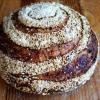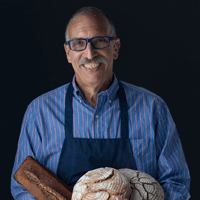So in response to a recent post, I decided to try Beth Hensperger's Sennebec Hill bread for myself, to see if the original recipe was problematic as I initially suspected. This is an enriched multigrain bread with 3 different flours, as well as rolled oats and yellow cornmeal.
Some adaptation was necessary, because as I have no bread machine. Fortunately guidance is easy to come by: in Hensperger's book, she notes that her recipe originates from Bernard Clayton, and his version can be found in New Complete Book of Breads, Soups & Stews. Clayton's version appears to use slightly more whole wheat flour and slightly less water than Hensperger's. He also uses very hot water (120-130F), which I suspects help rehydrate the ingredients more quickly, and promote some level of gelatinization.
So in the bowl of my trusty KA mixer, I combined all the dry ingredients, including dry milk powder, salt and yeast.

After whisking these together, I added the egg yolks, oil, molasses and water. In deference to the previous recipe, I only added 1 cup of water, and reserved the remaining 1/4c., as it was reported that the dough was very sticky and unmanageable. I mixed to combine on the KA's lowest speed for 1 minute with the dough hook.

Here's the result after 1 minute of slow mix; still rough, all not quite incorporated.

I don't know how long a bread kneading cycle typically is, I'm sure it varies from machine to machine, so I'm eyeballing this. Clayton specifies 8min of knead time by hand or mixer.
So after this rough mix, I cranked up the mixer for 2 min at KA speed #4.
As you can see from the photo below, it was still very shaggy, loose and goopy after those 2 min of mixing, as you can see from the picture below.

Seeing how shaggy it was, I let the barely-mixed dough rest for 5 minutes, to help the flour, oats, and cornmeal absorb some moisture.
I then unleashed the KA again, for 5 more minutes at speed #4. About 1 minute before mix was completed, I scraped the bowl down again, as the mixer was starting to bog (!) from the horizontal structural "blanket" that had formed. Mixer wasn't even hot, but it's the first time I've heard the mixer bog mixing any dough, including some of the high % ryes that I do.
Here's how it looked right after 7 min of mixing was completed:

Looks slightly sticky, but really it was just "post-it note tacky". Shaped easily into a smooth dough ball with no additional flour on the board.

I let it rise for 1 hour in my microwave alongside 4c. of boiling water (which creates a nice humid fermentation, at temps between 80-85F). It had almost exactly doubled during that time.

Again, a very soft and supple dough, not sticky at all, and very little elasticity. Notice the finger prints that remain.

Weighed this dough ball after rising, weight was 842g.
Flattened it into a rectangle, rolled it up, and into a bread pan dusted with a bit of flour to help release.

Then I set the oven to preheat to 375F.
Back into the microwave with the hot water for final proof; here's what it looked like at 30 minutes elapsed:

Not quite 1" above top of pan, so I let it rise another 10 minutes, at which point it was fully risen (total rise time 40 min). Passed poke test, so it was ready to go.

Gave it a light slash, sprayed the top down generously with water. I always tend to slash the tops of my loaves, in this case, perhaps I don't need to.
Set it to bake on middle rack at 375F for 2 min, then turned it down to 350F for 18min; rotated in the oven after 20min elapsed, here's what it looked like as I rotated it:

Total bake time of 40min. When removed, internal temp of bread was 206F, and this is what it looked like:

Baked weight was 782g, which is closer to a 1.75lb loaf.

And the crumb?

I found the crumb a bit too tight and dry for my tastes. It does have some shreddability, but not enough moistness. Could be because of slightly reduced hydration, or long bake, or both.
Flavor? Nothing specific jumps out. You get a little bit of crunch from the corn meal (either you like that or you don't, I'm impartial to it), and a faint muskiness from the combination of rye and molasses. A decent sandwich loaf with whole grains, not mind-blowing. Overall found it to be slightly dull & flat-tasting, compared to other breads I've baked; this may be a combination of short warm rise, high yeast, and intensive knead conspiring to reduce flavor.
For next time? I revise my initial assumption and say that it will probably work with the original amount of water (1.25c), but I suspect that it will be pretty sticky and shaggy, and require more careful handling, or similar knead and regular bowl scraping to get it to come together. Or perhaps a slightly shorter bake. Maybe a touch more salt, or some more sweetening (I think honey in lieu of molasses would be nice). Ars Pistorica's prior suggestion of an overnight rest in the fridge, maybe with a bit less yeast, would help boost the flavor.
So here's my adaptation:
Cranbo's Hilly Sennebec Bread
(I'll come back and provide weight measurements later)
1 1/2 cups KA all purpose white flour
3/4 cup KA whole wheat flour
1/2 cup Bob's Red Mill dark rye flour
3 tablespoons rolled oats
3 tablespoons yellow cornmeal
3 tablespoons toasted wheat germ
1/2 cup nonfat dry milk powder
1 1/2 tablespoons KA vital wheat gluten
1 1/2 teaspoons table salt
2 1/2 teaspoons active dry yeast
3 tablespoons vegetable oil
2 tablespoons molasses
2 large egg yolks
1 cup cool tap water + 1/4 cup cool tap water (reserved if necessary)
Instructions:
- In mixer bowl, whisk all dry ingredients together.
- In small bowl, whisk oil, molasses, egg yolks, and 1c. of water.
- Mix until all ingredients combined, rest 5 min (or up to 20min)
- Knead for 7 min at medium speed with dough hook (KA speed #4); scrape down bowl during this process as necessary (or every 2 minutes).
- Shape into ball, place in oiled clear container, let rise in warm humid place until doubled, about 1hr.
- Now preheat oven to 375F
- Take risen dough, flatten into rectangle, roll like log.
- Place in 5x9 bread pan, let rise in warm humid place until about 1-1.5" above pan edge, about 40min.
- (Optional: slash and mist loaf with water)
- Place on middle rack in oven, reduce heat to 350F and bake for 30-40 min, until desired browning is achieved and internal temp is at least 190F.
- Remove from oven. If desired, brush top crust with melted butter.
- Let cool on rack for at least 30 min.



















